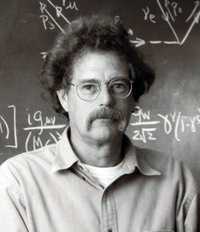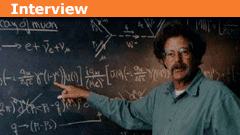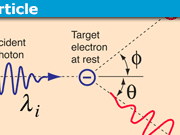Interview with Physicist David J. Griffiths
 We are pleased to introduce David J. Griffiths. Professor Griffiths is one of the most successful physics textbook writers. Odds are if you studied physics in college, you’ve used one of his textbooks. We are pleased and honored to obtain some of his insights on the quantum and academic world. Here we go!
We are pleased to introduce David J. Griffiths. Professor Griffiths is one of the most successful physics textbook writers. Odds are if you studied physics in college, you’ve used one of his textbooks. We are pleased and honored to obtain some of his insights on the quantum and academic world. Here we go!
Table of Contents
Please give us a background on your educational background and work experiences
High School(1960): my last two years were spent at Putney, a tiny boarding school on a farm in Vermont. This is relevant, because the framework for all the physics and mathematics I later learned was provided by Ed Shore, my teacher there. To this day, when I approach a physics problem or calculate an integral, I think about it in the language he taught me.
University: BS (Harvard, 1964); PhD (Harvard, 1970), elementary particle theory (Advisor: Sidney Coleman).
Post-Docs: University of Utah (1970-1972) and University of Massachusetts (1972-1974); both of them involved part-time teaching.
Employment: Mount Holyoke College (1974-1977); Trinity College (1977-1978); Reed College (1978-2009); I taught again at UM and MHC, and also at Smith and Amherst (2001-2002), and at Stanford (2007); sabbaticals at SLAC, Berkeley, and LBL.
*[For more information you can visit his academic webpage here.]
Please speak about the high prices of textbooks and the future of open source textbooks
In my experience there are two things over which an author has very little control: the cover, and the cost. Commercial publishers charge obscene prices for one reason: because they can. This is capitalism gone crazy: the person who chooses the product (the professor) is not the one who pays for it (the student), and none of the usual competitive constraints apply. I am pleased to say that in the case of my Quantum book I have extracted myself from Pearson, switching to Cambridge University Press, and the identical book now sells for less than half what Pearson was charging.
I like the idea of open source textbooks, although an enormous amount of work goes into the writing of a good book, and I do think there should be reasonable compensation to the author, both in fairness and as a disincentive for sloppiness. However, I detest the idea of customized “cut-and-paste” books. A good book (even—or perhaps especially—a physics textbook) has a coherent story line, and ripping out sections (or, as one publisher has done to me, removing all cross-references) is like taking the breadcrumbs out of Hansel and Gretel; it ruins the story. I realize, of course, that not every student is going to read every page, but the book itself should remain intact, as written.
What do you believe is the most difficult thing about teaching undergraduate quantum mechanics, and what is the biggest hurdle for the students trying to learn it?
The most difficult thing for the teacher to provide, and the student to develop, is a coherent framework for thinking about the subject. Classical mechanics is intuitively satisfying: state Newton’s second law and most people’s reaction is “Of course, why didn’t I think of that?” But quantum mechanics is radically counter-intuitive, and to learn the subject one needs a kind of skeleton to hang the various pieces on, and give some structure to the body.
As teachers, we tend to say too much. Because we know the subject is difficult to understand, we find ourselves, like a lawyer before a skeptical jury, presenting inconsistent arguments in the hope that one of them will stick. “Well, sometimes it behaves like a wave, and sometimes like a particle.” What is someone new to the subject supposed to make of a statement like that? Bohr had a nasty habit of elevating every half-baked idea to the status of a cosmic principle, and most instructors feel obliged to follow his lead, even if they do not themselves find the principle intelligible. What on earth does the Complementary Principle really mean? If it doesn’t make sense to you, then don’t teach it—it surely won’t make sense to your students. But it will leave them with the queasy feeling that something fishy is going on, and that’s precisely what we must try to avoid.
Has the way that we teach QM to undergraduates changed appreciably in the years since you first had to learn it as an undergrad yourself?
Yes. In the early ’60’s the older professors could still remember their own struggles to adjust to this radical new way of thinking. They took it for granted that we, too, had to be dragged kicking and screaming out of our comfortable classical playpen. So they spent weeks at the beginning trying to persuade us that classical mechanics was fatally flawed. After a month on the 19th century theory of blackbody radiation I could feel (if not really understand) Planck’s frustration. But my generation didn’t need all this—we had heard about quantum mechanics since grammar school, and we were anxious to get down to business. I was determined that if I ever taught the subject, Schrodinger’s equation would appear in the very first lecture. [One of the problems with an overly historical approach to the subject is that quantum mechanics actually began with the photon, and the photon is a relativistic particle if there ever was one; it has no proper place in nonrelativistic quantum mechanics—it belongs to a quite different subject: quantum field theory. If quantum mechanics had started with electron diffraction, then perhaps the historical route would make better sense. But in point of fact that came much later.]
How much airtime should foundational/interpretational issues get in an intro/undergraduate course?
I think they do definitely belong—after all, this is what makes the subject so fascinating. But there is a real danger in providing answers before the student is in a position to understand the questions. So I prefer to address these issues later in the course. The theory of spin, for instance, is the perfect place to discuss the meaning of the statistical interpretation—what do eigenvectors and eigenvalues have to do with the measurement process? Bell’s theorem absolutely belongs, but probably at the end of the semester.
Quantum mechanics seems to attract more bad (oversimplified or misleading or overwrought or ….) popularizations than most other branches of physics. Why is this, and is there anything that can be done about it?
Indeed! I think there are two villains here: (1) Physicists, who are (rightly) desperate to explain to the world the extraordinary, fascinating, and profound implications of quantum mechanics. But they are afraid of intimidating an audience that gags at the sight of an equation; they want to convey the excitement without the substance. So they resort to forced similes and grossly misleading metaphors (quantum tunneling means you can walk through walls—somehow it never works when I try it). (2) Non-physicists who are intrigued by words like “uncertainty” and “indeterminacy,” but are too lazy to do the serious work it takes to understand them. (I say “lazy,” not “incompetent,” because in my experience very few people are actually incapable of learning physics, if they set their mind to it—their problem is a short attention span. As soon as it starts to require hard work, they lose interest. That’s fine: physics is not for everyone. But then don’t pretend you are genuinely interested in it.)
What is your advice to a layperson who is interested in QM but lacks the math background to take on a serious undergraduate course?
Learn the math. You’ll be glad you did, whether you take the QM course or not.
How should aspects of how we teach [intro and intermediate] Classical Mechanics be modified to better prepare us for Quantum Mechanics? Which topics should be more emphasized? de-emphasized?
I don’t think they should be. Classical mechanics is a very different subject, from which quantum mechanics does not emerge in any natural way. There is a school of thought that says you should develop classical mechanics up through Poisson brackets: change the shape of the parentheses, slip in an h-bar or two, and presto—you’ve got quantum mechanics! I like to emphasize, to the contrary, that quantum mechanics is a radically different theory, with different epistemology and different strategies. I’d like the students to know what a Hamiltonian is, but that’s about it. (Well, OK: and mass, momentum, potential energy, and angular momentum.) Study classical mechanics by all means, as a worthy subject in its own right, but don’t think of it as the necessary precursor to quantum mechanics.
Are you currently writing (or planning to write) any new books? If so, in what areas?
Nope. I’m working on a third edition of my Quantum book, and helping to edit a posthumous Quantum Field Theory book by my PhD advisor Sidney Coleman. That’s enough for now.
What textbooks were your favorites when you were a student?
Purcell’s “Electricity and Magnetism” was my absolute favorite (but I didn’t encounter that until I was a graduate student). I think the first edition of Resnick and Halliday was a good book—I wish they would reprint it. It had no glossy colored pictures, but you could actually carry around it without a forklift; it had everything you needed to know—no more. Gillespie’s “A Quantum Primer.”
Please describe your process for writing textbooks. It seems like a daunting task.
My books all began as lecture notes. I rewrote them, and polished them, every time I taught the subject, and after six or seven iterations it was relatively easy to convert them to book form. I could never write a book from scratch, without this incremental sequence of successive approximations.
As a student, did you tend to learn more from your professors’ lectures or from the textbooks you used?
With rare (but extraordinary) exceptions the lectures I attended as an undergraduate were unintelligible, so I guess I learned more from textbooks—but most of all by working lots and lots of problems.
That wraps up the interview. David J. Griffiths will consider answering direct follow-up questions but due to his busy schedule is unable to engage in back-and-forth discussion.
Read the next interview with physicist Clifford V. Johnson
I have a BS in Information Sciences from UW-Milwaukee. I’ve helped manage Physics Forums for over 22 years. I enjoy learning and discussing new scientific developments. STEM communication and policy are big interests as well. Currently a Sr. SEO Specialist at Shopify and writer at importsem.com








[QUOTE="Kibble, post: 5643959, member: 611368"]it is possible to present the vast majority of them to a non-physicist without sacrificing accuracy.[/QUOTE]More precisely, it is possible to present a small, carefully chosen sample of the vast majority of them to a non-physicist without sacrificing accuracy. For example, you mentioned Feynman's The Character of Physical Law, which I agree is an excellent layman's presentation. But it is an excellent layman's presentation of…not very much, from the scientist's point of view. It gives you a taste of what's out there, and a quick overview of our current theories, but that's all. It certainly doesn't give an explanation of difficult and important concepts like the ones Hestenes mentions. At least Feynman is honest enough to admit that he's leaving a lot out; many scientists, when presenting to lay people, fail miserably at doing that.If you want to see how the same scientist, Feynman, presented the same material to non-lay people, try the Feynman Lectures on Physics (which are now available for free online at Caltech's website). It takes him three full volumes, dense with math as well as careful descriptions of experimental setups and results, to cover the range of topics he skims over in The Character of Physical Law. That gives you an idea of how much is being left out in the latter book.
[QUOTE="Kibble, post: 5643959, member: 611368"]For example, I love music. I feel that I have a genuine interest in it. I can't play any instruments and do not know music theory[/QUOTE]There is a vast difference in loving music and creating music others love.I perceive a sense of entitlement amongst many lay people in music , physics, art……
I may be alone in this, but I find this statement troublesome:[QUOTE] (2) Non-physicists who are intrigued by words like “uncertainty” and “indeterminacy,” but are too lazy to do the serious work it takes to understand them.[/QUOTE]The language he uses here, and throughout the interview, seems to reinforce the rift between the lay-person and the scientist. While it is certainly true that some physical concepts require a lot of math to fully develop, it is possible to present the vast majority of them to a non-physicist without sacrificing accuracy. (See Allan Adam's opening lecture on QM or Feynman's QED, Character of Physical Law, etc).His logic really doesn't work. It is possible to have a genuine interest in something without wanting to devote vast swathes of you life to it. For example, I love music. I feel that I have a genuine interest in it. I can't play any instruments and do not know music theory.Elitism drove most of my undergraduate class away from physics. You don't have to be Einstein to understand relative motion.
Thank you for this interview. Griffiths has interesting things to say. I particularly like his statement to "Learn the math" … a view that I wholeheartedly hold. It is where the wheat is separated from the chaff … so to speak …
[QUOTE="vanhees71, post: 5578281, member: 260864"]… to really learn a subject or read a paper carefully, for some reason I need to print it on paper to work through it carefully.[/QUOTE] Same here. I need to flip back and forth when reading something technical. Science may be 'linear thinking', whatever that means, but I can only learn it if I refer to those parts of the exposition that came before my place in it. Really thinking about a subject, not only the sciences perhaps, requires going over an understanding I have formed by a certain point in the text and to catch the 'true meaning' and nuances of the subject. For some reason, that's not so easy when I don't have all the pages in my hand at once. Scrolling back and forth on a screen just doesn't cut it for me.
His book "Introduction to Electrodynamics" is so well written and really gives you a very good aspect on the topic!
[QUOTE="Jilang, post: 5583017, member: 492883"]In that case your two expressions in post #21 are identical.[/QUOTE]of course not reread it carefully !!!
[QUOTE="Jilang, post: 5582578, member: 492883"]@shreras, why would you assume that dC/dx is the same in both cases overall the integral?[/QUOTE]As the derivation shows, in fact it is. The capacitance doesn't depend on the amount of charge or the applied voltage on the capacitor!
In that case your two expressions in post #21 are identical.
[QUOTE="Jilang, post: 5582578, member: 492883"]@shreras, why would you assume that dC/dx is the same in both cases overall the integral?[/QUOTE]oh it's just variation of capacitance wrt x (distance moved by dielectric, inside capacitor) – so of course it's independent of everything else (Q,V …..- whatever)!!
Would love to meet him one day.Reed College is only 6.7 miles from my house.I'd love to hear him laugh at my interpretations of QM, after a couple of pints, at the Horse Brass.I'll buy! :biggrin:
@shreras, why would you assume that dC/dx is the same in both cases overall the integral?
They are not as demonstrated by Griffiths. If you don't want to believe a clear mathematical derivation, I cannot help you.
[QUOTE="Shreyas Samudra, post: 5581739, member: 538084"]Look at the final expressions of forceIn case one and twoThey aren't equal !!![/QUOTE]Give it a fresh thought I am sure about itWhen we insert dielectric in a parallel plate capacitor(which is not connected to battery)Q on it will stay constant, but V will changeSo, force on dielectric at some instant is1/2 V^2 dC/dx , wherein V is changing(x is distance moved by dielectric inside capacitor)But when the capacitor is connected to battery V is constant,So force on dielectric at some instant is1/2 V^2 dC/dx , wherein V is constantSo essentially forces are different in these two cases
Well, in Griffiths's and my derivation (which are identical) they are the same, and they should obviously be.
Look at the final expressions of forceIn case one and twoThey aren't equal !!!
In case (a) we calculated the change of ##V##, which is due to the change in ##C## when expressed in terms of ##Q=text{const}## and ##C##. In case II we have exactly considered the case of constant ##V## which implies that also the charge changes and that you have to take into account the corresponding work done by the battery to provide the change of charge. So we exactly did what you claim we didn't!
Oh man I clearly pointed out the mistakeThe force in case I is varying not only due to dC/dx but also due to variation in V(potential difference across the plates- it changes as we move the dielectric)But in case II V will never as we have battery, maintaining it constant !!
But Griffiths gives a very clear proof in his book. It's as follows(a) Keep the capacitor charged with total charge ##Q## (disconnected from the battery). The electric energy stored in it is$$W=frac{Q^2}{2C},$$and thus$$vec{F}=-nabla W=frac{Q^2}{2C^2} vec{nabla} C.$$Now you can get the capacitance with the dielectric moved in by ##x## (as in Griffiths's Fig. 4.30) as a parallel circuit of two parallel capacitances: One capacitor is of length ##x## and width ##w## filled with vacuum (or air) where ##epsilon=1## and the other part is filled with the dielectric with ##epsilon## as the dielectric constant. Thus you have (in Heaviside-Lorentz units)$$C=C_1+C_2=frac{w}{d}[x+epsilon_r(l-x)]=frac{w}{d}(epsilon_r l-chi_e x),$$where ##chi_e=epsilon_r-1## is the electric susceptibility of the dielectric. Thus you get$$vec{F}=frac{Q^2}{2C^2} frac{-chi_e w}{d} vec{e}_x=-frac{V^2 chi_e w}{d},$$which is exactly what Griffth's gets out too.(b) Capacitor plugged to the batteryThen when moving the dielectric by some infinitesimal ##mathrm{d} x## the capacitance changes a bit and thus to keep the voltage constant you have to move some charge$$mathrm{d} Q=mathrm{d} x frac{mathrm{d}}{mathrm{d} x}(C V)=mathrm{d} x V mathrm{d C}{mathrm{d} x}=-mathrm{d} x frac{chi_e w}{d}.$$Thus the change in the electric energy due to this movement is$$F_x=-frac{mathrm{d} W_{text{tot}}}{mathrm{d} x}=-frac{mathrm{d}}{mathrm{d} x} left (frac{C V^2}{2}+V frac{mathrm{d} Q}{mathrm{d} x} = frac{V^2}{2} frac{mathrm{d} C}{mathrm{d} x} = -frac{V^2}{2} frac{chi_e w}[d},$$i.e., the same as in case (a). As I said, that's a very clear derivation, and I don't see where there should be a mistake. Perhaps you can point clearly at the point of the derivation where you think there is one?
:headbang::bow:the expression of force on dielectric when Q is constant1/2 V[SUP]2[/SUP]dC/dx ………….(i)here V changes as we move the dielectric in or out (-change in capacitance)the expression of force on dielectric when V is constant1/2 V[SUP]2[/SUP]dC/dx ……..(ii)here V stays constant (as we have connected battery)So , if we take two capacitors with same initial charge and capacitance ,and then insert same kind of dielectric in them following conditions I and II resp.THEN after having done with insertion , V in case I will not equal V in case IIHENCE force on dielectric in case I will differ from the one in case I:bow::bow::bow::bow:I
Of course for ##Q=text{const}## the voltage changes, but that's why Griffiths correctly expresses ##W## in terms of ##Q=text{const}## rather than ##V## when taking the derivative wrt. ##r##.He also correctly demonstrates what happens when ##V=text{const}## (e.g., by connected the capacitor to a battery): Then ##Q## changes and one has to take into account both the change of energy due to moving the dielectric against the forces (of the here cleverly neglected fringe fields!) as well as due to the transport of charges through the battery. As I said, I don't see anything wrong in his derivation in both cases.
[QUOTE="vanhees71, post: 5580907, member: 260864"]I don't see any mistake in the cited derivations in the textbook. It's of coarse the quasistatic approximation, i.e., any radiative effects are neglected.[/QUOTE]See the above reply
[QUOTE="Shreyas Samudra, post: 5580807, member: 538084"]Clarification-When the capacitor isn't connected to a battery V will change , so the force on dielectric (exerted by capacitor pates) in case when the capacitor plates are maintained at constant potential difference, will differ from the force exerted when the capacitor plates aren't maintained at constant potential difference.[/QUOTE]this is what i am talking about – mistake
I don't see any mistake in the cited derivations in the textbook. It's of coarse the quasistatic approximation, i.e., any radiative effects are neglected.
Hey SIr , (Addressed to Sir J D Grififfiths)Last year when I took basic electricity and magnetism course , my instructor discussed some intresting ideas which you discussed in your book ''Introduction to Electrodynamics'' ,one of that was calculating force exerted on a dielectric while it's to be inserted in a parallel capacitor(Chapter 4 Electric Fields in matter;page 196-7) Therein you have made one mistake ! -So said my instructor !!You said – [ATTACH=full]106738[/ATTACH]Reference-[ATTACH=full]106739[/ATTACH][ATTACH=full]106740[/ATTACH][ATTACH=full]106741[/ATTACH]Clarification-When the capacitor isn't connected to a battery V will change , so the force on dielectric (exerted by capacitor pates) in case when the capacitor plates are maintained at constant potential difference, will differ from the force exerted when the capacitor plates aren't maintained at constant potential difference.One more thing When we connect a capacitor to a battery directly , half of the work done by battery is stored in capacitor in form of electrostatic potential energy (and the other half is radiated out in form of electromagnetic radiations)So, as of the example of inserting dielectric in parallel plate capacitor , will there be any play of the phenomenon of energy being radiated out in form of electromagnetic radiations (as in the case I mentioned above) ?Thank you for reading Sir I am waiting for your replyYours enthusiastic student !-Shreyas Samudra
Great read. Thanks!I'm a fan of paper and accepting of PDF. Other formats, not so much.
"It had no glossy colored pictures.."- I hate those contemporary physics books where half the space is taken by glossy colored pictures of bridges, building, ferris wheels, etc.. All this in an attempt to look cool, contemporary, concrete. More look and less substance is not the best way to learn physics or math.
I think it's nice to have the textbook and the electronic version. Sometimes you get access to the electronic version when buying the book.
SS
[QUOTE="vanhees71, post: 5578281, member: 260864"]but to really learn a subject or read a paper carefully, for some reason I need to print it on paper to work through it carefully.[/QUOTE]For me the reason isn't mysterious. You can flex it so you can tilt the page easily while you're writing, the rigid support makes the thing more clunky. And most importantly you can look at multiple pages at the same time, or even multiple books/papers.
Sure, very many textbooks are available also as ebooks. For physics and other "math rich" texts, I always prefer the pdf version. E-book formats usually distort the formulae often to an extent to unreadability. I personally prefer paper books to work with. If I just have to look something up, it's ok to have a electronic version on my tablet/laptop, but to really learn a subject or read a paper carefully, for some reason I need to print it on paper to work through it carefully.
Can a gyroscopic force used instead of a counterweigth to stabilize a 12 metric ton gangway?
I wonder what people think of e-textbooks for tablets and such. Do they exist for technical courses?
I wonder what people think of e-textbooks for tablets and such. Do they exist for technical courses?
Feels nostalgic, back in my undergrad times I spent hours of exercises from his book for my Electromagnetism course. It is one of those books having the most entertaining and no-boring way of explaining complicated concepts. It's still my first recommendation for students starting their first classical electromagnetism class.